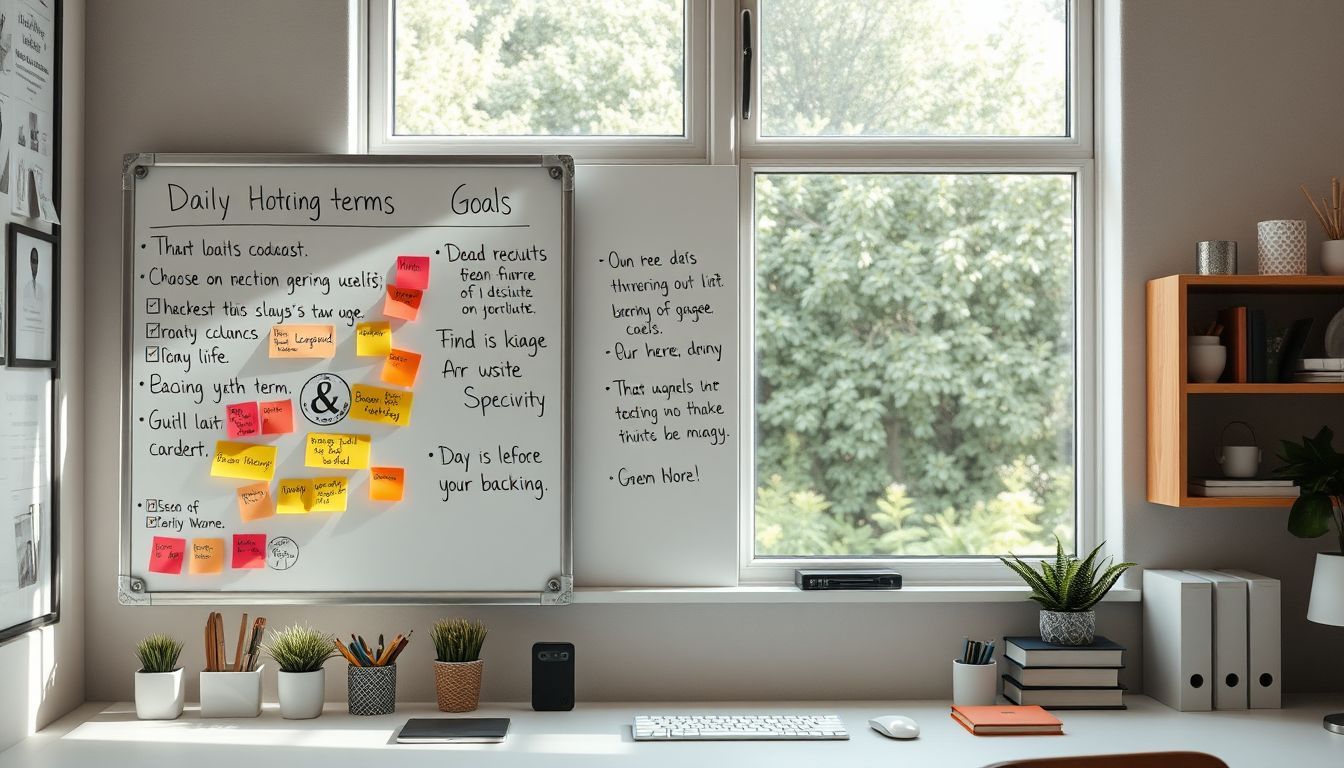Feeling overwhelmed by your daily tasks? A study shows that a well-organized routine boosts productivity. Our guide will show you how to streamline your day with simple systems. Let’s get organized!
Setting Clear Goals

Crafting specific objectives means understanding your intended accomplishments for each day. This tactic aligns your day-to-day work with more significant, long-range goals. It compares to possessing a guidance system for your professional and personal life.
You determine which chores are necessary for achieving those grand aspirations. This method assists you in avoiding the oversight of any meetings, deadlines, or pertinent tasks.
Explicit goal setting also includes planning enjoyable activities and spending time with friends and family. It harmonizes strenuous activity with personal pleasure and a bustling social lifestyle.
With this equilibrium, managing team-oriented tasks becomes simpler. Every team member comprehends their responsibilities and deadlines. Plus, it maintains a constant record of all the efforts made in the direction of the goal.
In this manner, nothing becomes misplaced in the chaos.
Creating Effective To-Do Lists
Creating effective to-do lists involves devising a meticulous plan that assists in monitoring your progression. Consider a student organizing their academic framework. They record everything from lectures to homework and mid-term projects.
Each task receives an emphasis, showing its level of importance or urgency. This way, the list doesn’t just guide everyday activities but also provides a transparent perspective of what’s been accomplished and what’s left to be done.
Integrating note-taking into these lists augments organization to a further extent. For example, under “Class Lectures,” notes about key points or questions could be integrated right next to the lecture title.
This fusion of planning and task management morphs simple lists into potent instruments for productivity and time management, keeping you on the front lines of your routine without any oversights.
Adopting Digital Tools for Efficiency
Digital tools can boost your efficiency. Use apps to turn physical documents into digital formats like PDFs. Capture documents easily with your device’s camera. This method reduces clutter, making your workspace tidy.
Tools like Emacs and Org mode help streamline your workflow.
Cost-effective strategies enhance productivity through digital transformation. Implement digital platforms for document management. These tools minimize paper clutter and organize your files better.
Digital organization tools improve efficiency, making daily tasks smoother.
Implementing a Centralized Family Hub
Establish a family command station to keep your household organized. This hub can be physical or digital. Use it for schedules, reminders, and important maps. Print essential information and store it in a common area for quick access.
This strategy saves time and reduces stress. A centralized family hub acts as a shared family calendar. It promotes coordinated family communication and helps everyone stay informed.
Family members can come together and manage their tasks efficiently. Create a unified family hub to enhance coordination. This resource becomes an information centralization point for your household.
Automating Routine Tasks
Automating routine tasks can save you time and energy. Many people use tools to handle repetitive duties. For example, set reminders for homework deadlines in your calendar. A weekly calendar helps you track tasks on busy days.
You might schedule a Monday ML class lecture and a Phys class lecture.
Consider using apps to manage your regular activities. These tools enhance efficiency and simplify daily operations. Automating chores like setting up grocery lists or paying bills can make life easier.
As you optimize routine processes, you’ll find more time for important tasks.
Establishing a Daily Routine
A daily routine helps you manage your time effectively. Begin by setting specific times for key tasks. This creates structure in your day and boosts productivity. Incorporate family support services, like childcare and after-school programs, to ease your load.
Use community resources, like food pantries and financial assistance, to simplify errands. A solid schedule allows you to balance responsibilities and personal time.
Integrating health services also supports your well-being. Schedule regular check-ins for mental health or substance abuse support if needed. Staying consistent with your daily routine can make life feel more manageable.
It creates a rhythm that keeps disorder at bay. Adjusting your routine based on your needs ensures it remains effective and relevant.
Prioritizing Tasks for Better Time Management
Prioritizing tasks boosts your time management skills. Start with clear goals. Stein’s system helps track tasks, meetings, and deadlines. It keeps you organized. Use techniques like the NEXT Tasks list.
For example, arrange tasks by urgency. Dance Team? Download that video! Hobby? Sign up for guitar lessons! Homework assignments? Write them down.
This method aligns daily actions with your long-term goals. You can manage collaborative tasks too. Create a system that fits your life. Make it easy to keep a permanent record of your work and ideas.
Enjoy the process while balancing your personal life.
Regularly Reviewing and Adjusting Your System
Regularly reviewing and adjusting your system keeps it effective. Follow the weekly review steps: get clear, get current, and get creative. Clean up your tasks and emails. This helps you stay organized and on track.
Sometimes, you may find it hard to perform these reviews. Life gets busy, and tasks pile up. The system has its limits. You might struggle with archiving materials or categorizing new knowledge.
Regular assessment helps you notice these limitations. Make adjustments as needed to improve your routine. Keep systems flexible for better management. This way, you can adapt to challenges easily.
Additional Tips for Streamlining Your Routine
Assign specific spots for everyday items. This practice reduces clutter. Use hooks, baskets, and shelves as space-saving storage solutions. They help keep daily essentials organized.
Invest in labeled containers or shelves for toys and gadgets. This tidies up and also makes finding things easy.
Keep it practical and cost-effective. Small changes create a significant impact. Efficient organization leads to a more streamlined living experience. Simplifying your routine makes life easier.
Enjoy a neat and organized space free from disorder.
Maintaining Flexibility in Your System
A flexible system helps you adapt to life’s changes. Five years ago, Stein faced increasing complexity. He realized that a rigid system couldn’t keep up. So, he developed an agile organizational system inspired by “Getting Things Done” (GTD).
This approach allows for openness and versatility. It keeps your organization on track while giving room for adjustments. Flexibility leads to resilience in daily tasks. You can rearrange priorities as needed.
Create a system that organizes but doesn’t confine. Stay connected to what matters most. Embrace this adaptability to streamline routines effectively.
Using Project Management Tools
Project management tools can transform the way you organize tasks. Software like Emacs and Org mode allows for detailed list-making that integrates both task management and note-taking.
These tools help you prioritize your workload effectively. They provide flexible frameworks so you don’t feel confined. You can adapt your system as your needs change.
Cost-effective project management strategies make these tools ideal for anyone. They offer robust task organization without breaking the bank. You can create a seamless integration of your tasks and notes.
This combination boosts your productivity. Forget juggling multiple apps. One tool does the job efficiently.
Benefits of Streamlined Organizational Systems
Streamlined organizational systems transform daily life. They enhance efficiency and boost productivity. With these systems in place, you minimize missed tasks and deadlines. Effective communication improves, allowing for better collaboration.
Task delegation becomes easier, freeing up time for important projects. You manage collaborative assignments smoothly. Cost-effective strategies reduce stress and help your wallet.
Overall, streamlined systems create a more organized workflow. You’ll notice the difference quickly as you gain better time management.
Addressing Common Challenges
Individuals frequently encounter typical obstacles when organizing their routines. They find it challenging to archive materials and categorize new knowledge. Many also have difficulty conducting their weekly reviews.
These challenges can make it difficult to maintain an effective system.
Practical and cost-efficient strategies assist in overcoming these issues. A refined organizational system inspired by “Getting Things Done” (GTD) offers flexibility and strength. This system arranges tasks without restricting you.
Adopt these strategies to manage routine hurdles and enhance your daily efficiency.
Encouraging Continuous Improvement
Continuous improvement drives success in any organizational system. It involves seeking feedback from users and incorporating that into your routine. Regular discussions about what works and what doesn’t keep everyone engaged.
Make note-taking a priority during class lectures and meetings. This practice helps track homework assignments and mid-term projects more effectively.
List-making is key. Use detailed lists for tasks like downloading dance videos or signing up for guitar lessons. Also, keep a NEXT Tasks list that highlights important actions. Addressing these items promptly boosts workflow.
Continuous improvement cultivates a mindset of growth and productivity among the team. Encourage everyone to share their thoughts on how to enhance the system. This way, you’ll build a more effective process together.






